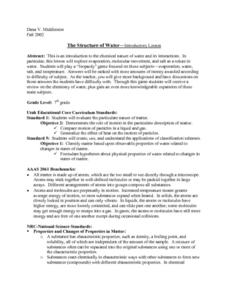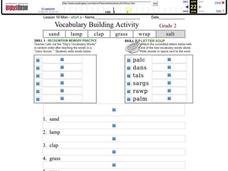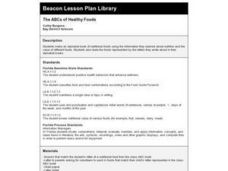Curated OER
Greece: The Landscape
Learners work in small groups to create a topographic map of Greece. They must include labeled line drawings of bordering countries and bodies of water. Students use salt and flour clay to make Greece three dimensional, showing the many...
Curated OER
The Chemical Nature of Water
Seventh graders simulate a Jeopardy game to examine the chemical nature of water. Among the topics featured are evaporation, water, salt, and temperature. finally, as review, 7th graders answer a battery of questions presented by the...
Curated OER
Bodies of Water
In this writing descriptive sentences activity, students describe 13 different bodies of water using the words small, large, fresh, salt, deep, shallow, protected, still, and flowing. Students should include 2 adjectives per sentence.
Curated OER
Cleaning Pennies
Students observe changes in a penny when it is cleaned. In this scientific inquiry lesson, students use a dixie cup filled with vinegar and salt, and drop the penny into the water. Students observe the changes.
Curated OER
Crystals: What Are They and What Holds Them Together
Students are introduced to the characteristics of crystals and what keeps them together. Using the Periodic Table, they examine the various elements and develop a model of an atom. In groups, they place sugar and salt in petri dishes...
Curated OER
Rusting and the Scientific Method
Pupils observe the oil can scene with the tin man from a clip from "The Wizard of Oz" and answer the question, "What can we learn about rust from this scene?". They take 2 tubes and 2 nails, adding 1 salt packet to 2 ml of distilled...
Curated OER
Effects of the Southern Pacific Railroad Causeway
Fifth graders describe the appearance of a substance before and after a physical change. They re-create the Southern Pacific Railroad Causeway across the Great Salt Lake. They determine for themselves how the water is exchanged...
Curated OER
The First Farmers
Students show how constant irrigation, with repeated evaporation of water that left salts in the soil, eventually ruined much farming land in southern Mesopotamia. They discuss the idea that with the development of irrigation people...
Curated OER
Heritage: Going Into Business
Students plan a transport business to run between Independence, Missouri and Salt Lake City, Utah between 1850-1860. They make and display a poster advertising their freight line. They show a picture of the vehicle, give the name of the...
Curated OER
Food Additives
In this food additives worksheet, students will read information about the use of curing salt and ion nitrates to preserve food and the health problems that can occur from using these substances. Students will then answer 4 short answer...
Curated OER
Past Modals: It Must Have Been Terrible!
In this language arts worksheet, students study the past modal phrase "must have" in response to a situation. Students collaborate in pairs with one person reading a situation and the other choosing the most appropriate response from...
Curated OER
Feely Balloons
Students use their sense of touch to identify different types of solids. In this "Mystery Solids" lesson, students feel various balloons filled with items such as rice, flour, salt, beans, etc. They use their senses to come to logical...
Curated OER
Give Me a Hand, I'm "Thumb-body" Special
Students label the bones in the hand, create a model of the hand, compile a set of fingerprints, and explore the importance of the thumb. In this anatomy of the hand lesson plan, students participate in six hands-on activities to...
Curated OER
Do You Know Where the Juice Is? Conversation Practice
For this conversation worksheet, students investigate the names of items in a refrigerator. They practice having a conversation about the location of the items and write answers to 4 questions about items such as peanut butter, salt, and...
Curated OER
Wetland Ecosystems: Non-living and Living Components and Brine Shrimp
Students explore wetland ecosystems. In this wetland lesson, students discuss and observe salt ponds and the organisms that live there. They explain how abiotic and biotic factors of species are important to survival.
Curated OER
Tongue Map
Students explore human anatomy by conducting a human senses experiment. In this taste lesson, students identify the main purpose of a tongue and how it enhances our eating habits. Students utilize baking coca, lemon juice, salt and honey...
Curated OER
Vocabulary Building Activity: Short A
For this short a worksheet, 2nd graders write down six vocabulary words as they are called out, unscramble six vocabulary words and then write each one in a complete sentence using five or more words in each one.
NOAA
What's a CTD?
Why are the properties of the water important when exploring the ocean? Young scientists discover the tools and technology used in deep sea exploration in the fourth installment in a five-part series. Groups work together to examine...
Towson University
Berries...With a Side of DNA?
Sometimes science lab can be ... delicious! Middle school science scholars extract DNA from strawberries and other fruits in an engaging lab activity. The teacher's guide includes pacing, materials list, and worksheets with answer keys.
Curated OER
Ocean Water
Given data about the composition of ocean water, students complete 5 different questions using a provded table that relate to the ocean water (with elements Chloride, Sodium, Sulfate, and Magnesium). Some questions require calculation,...
Curated OER
Electrochemistry Problems
In this electrochemistry worksheet, students determine the voltage of a cell based on the reduction potentials. Students write a condensed cell diagram and the oxidation half reaction for the cell. This worksheet has 30 problems to solve.
Curated OER
Chillin' Out with Freezing Point Depression
Learners examine the freezing point depression of salt water by making ice cream. Lab activity begins with students layering a bowl with ice and salt around an empty cup before adding a mystery solution to the cup. They take the...
Curated OER
The ABCs of Healthy Foods
First graders, after reviewing the food pyramid, look for fat, sugar, and salt in food.
Curated OER
"Pandemic" A Disease Simulation
Students use small test tubes with water, salt and a silver nitrate solution to simulate the spread of infectious disease contracted the exchange of bodily fluid. They problem solve to track the original source of infection.
Other popular searches
- Salt Dough Map
- Salt Water
- Salt Marshes
- Salty Oceans
- Gold and Salt Trade
- Great Salt Lake
- Epsom Salt
- Salt Water Chemistry
- Fresh Water Salt Water
- Mahatma Gandhi Salt March
- Growing Salt Crystals
- Freshwater and Saltwater

























